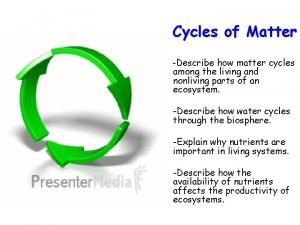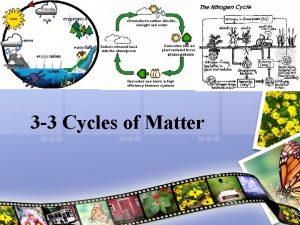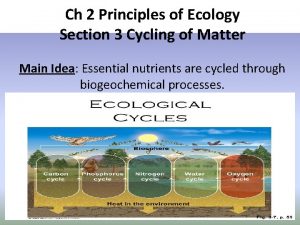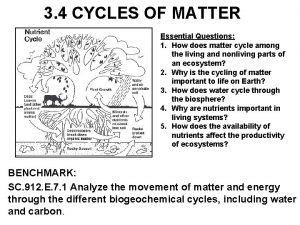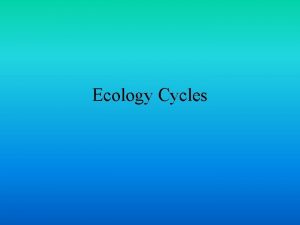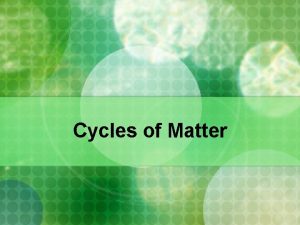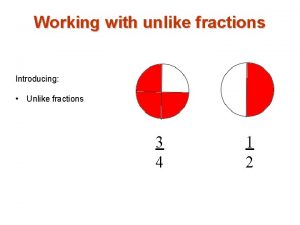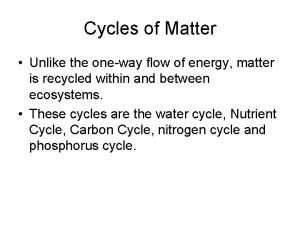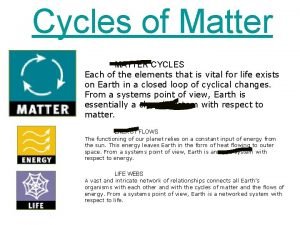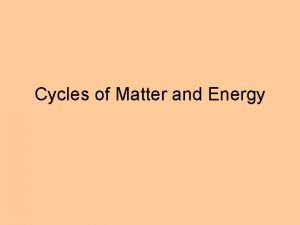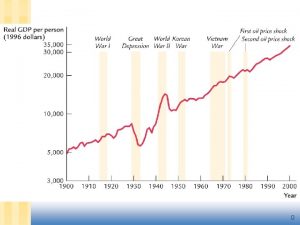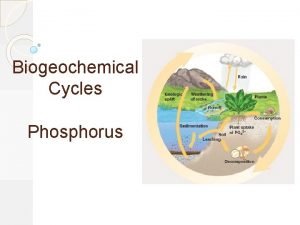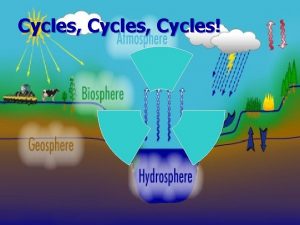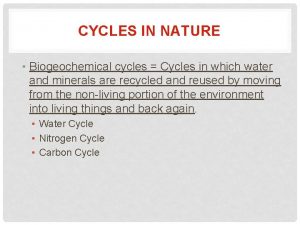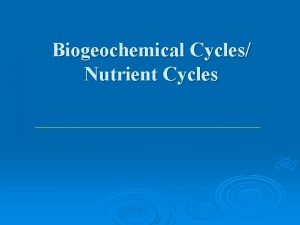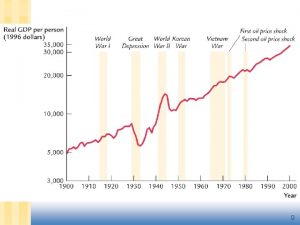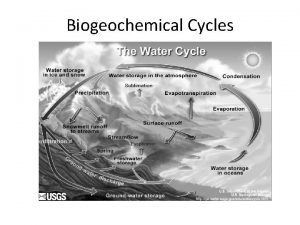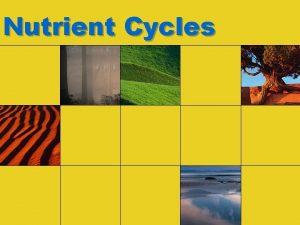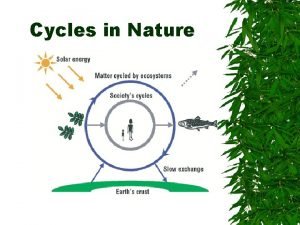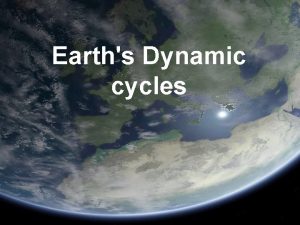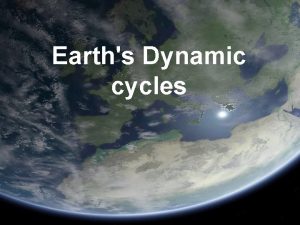Cycles of Matter Cycles of Matter Unlike the






















































- Slides: 54

Cycles of Matter

Cycles of Matter Unlike the one-way flow of energy, matter is recycled within and between ecosystems.

Cycles of Matter Unlike the one-way flow of energy, matter is recycled within and between ecosystems.

Cycles of Matter I. Biogeochemical cycles – Process in which elements, chemical compounds, and other forms of matter passed from one organism to another and from one part of the biosphere to another

Cycles of Matter • Biogeochemical cycles – Biological Geological Chemical Cycles are all connected

The Water Cycle A. Evaporation: process by which water changes from liquid form to an atmospheric gas B. Transpiration: water evaporating from the leaves of plants

The Water Cycle • Evaporation and transpiration occur

The Water Cycle • Evaporation and transpiration occur • Sun heats the atmosphere • Warm air rises, and eventually cools

The Water Cycle 1. Evaporation: Sun heats the atmosphere causing warm moist air to rise 2. Transporation: Heat from the sun causes plants to “sweat” and lose water through stomata into the atmosphere.

The Water Cycle 3. Condensation: Moist warm air will cool the higher it rises which causes water vapor to condense and forms clouds

The Water Cycle 4. Precipitation: When enough water condenses it will form droplets which will return to Earth’s surface in form of precipitation – rain, snow, sleet, or hail

The Water Cycle 5. Runoff: On land, water runs along surface until it enters streams, rivers, lakes or the ocean

The Water Cycle 6. Seepage: Some water also seeps into soil and becomes ground water and some of this water can be soaked up through the roots of plants.

The Water Cycle water cycle continue both day & night.

Nutrient Cycles

Nutrient Cycles • Benefits -

Nutrient Cycles • Benefits – – Every organism needs nutrients to build tissues and carry out essential life functions

Nutrient Cycles • Benefits – 1. Every organism needs nutrients to build tissues and carry out essential life functions a. Like water, nutrients are passed between organisms and the environment through biogeochemical processes

Nutrient Cycles • Benefits – 2. In many ecosystems, nutrients are in short supply • Thus recycling nutrients is essential for the ecosystem to keep functioning

Nutrient Cycles • Benefits – 3. Prevents many chemicals from reaching concentrations that would otherwise be toxic or harmful to organisms

Nutrient Cycles • Three cycles play especially prominent roles in the biosphere

Nutrient Cycles • Three cycles play especially prominent roles in the biosphere – The carbon cycle

Nutrient Cycles • Three cycles play especially prominent roles in the biosphere – The carbon cycle – The nitrogen cycle

Nutrient Cycles • Three cycles play especially prominent roles in the biosphere – The carbon cycle – The nitrogen cycle – The phosphorus cycle

The Carbon Cycle • There are four different kinds of processes involved in the carbon cycle

The Carbon Cycle • There are four different kinds of processes involved in the carbon cycle 1. Biological processes -

The Carbon Cycle • There are four different kinds of processes involved in the carbon cycle 1. Biological processes – photosynthesis, respiration, and decomposition of plants and animals

The Carbon Cycle • There are four different kinds of processes involved in the carbon cycle 2. Geochemical processes – release of carbon dioxide to atmosphere by volcanoes

The Carbon Cycle • There are four different kinds of processes involved in the carbon cycle 3. Mixed biogeochemical processes – burial of carbon-rich remains of organisms and their conversion into fossil fuels (coal and petroleum) by the pressure of overlying earth

The Carbon Cycle • There are four different kinds of processes involved in the carbon cycle 4. Human activity – including mining, the burning of fossil fuels, and the cutting and burning of forests

The Carbon Cycle • In the atmosphere, carbon is present as carbon dioxide. CO 2

The Carbon Cycle 5. In the atmosphere, carbon is present as carbon dioxide. a. This carbon dioxide came from 1. Volcanic activity 2. Respiration 3. Burning of fossil fuels 4. Decomposition of organic matter CO 2

The Carbon Cycle • Plants take in carbon dioxide CO 2

The Carbon Cycle 6. Plants take in carbon dioxide CO 2 a. The carbon is used to build carbohydrates during photosynthesis CO 2

The Carbon Cycle 7. The carbohydrates are passed along food webs to animals and other consumers CO 2

The Carbon Cycle 8. In the ocean organisms use carbon to make calcium carbonate CO 2

The Carbon Cycle 8. In the ocean organisms use carbon to make calcium carbonate a. This calcium carbonate accumulates in marine sediments and in the bones and shells of organisms CO 2

The Carbon Cycle b. These calcium carbonate compounds eventually break down and the carbon returns to the atmosphere CO 2

The Nitrogen Cycle • Nitrogen fixation -

The Nitrogen Cycle 1. Nitrogen fixation – process where nitrogen gas is converted to ammonia by bacteria found in roots of plants called legumes

The Nitrogen Cycle • Nitrogen required to make amino acids, which are used to build proteins. N 2 NH 3 NO 3 NO 2 -

The Nitrogen Cycle 2. Nitrogen required to make amino acids, which are used to build proteins. 3. When organisms die, decomposers return nitrogen to the soil as ammonia N 2 NH 3 NO 3 NO 2 -

The Nitrogen Cycle 4. nitrogen gas (N 2) makes up 78% of atmosphere N 2 NH 3 NO 3 NO 2 -

The Nitrogen Cycle 4. nitrogen gas (N 2) makes up 78% of atmosphere 5. Through nitrogen fixation, nitrogen gas converted to ammonia N 2 NH 3 NO 3 NO 2 -

The Nitrogen Cycle • Ammonia (NH 3), nitrate ions (NO 3 -), and nitrite ions(NO 2 -) are found in wastes produced by organisms N 2 NH 3 NO 3 NO 2 -

The Nitrogen Cycle 6. Ammonia (NH 3), nitrate ions (NO 3 -), and nitrite ions(NO 2 -) are found in wastes produced by organisms 7. These compounds taken up by producers to make proteins N 2 NH 3 NO 3 NO 2 -

The Nitrogen Cycle 8. Soil bacteria convert nitrates into nitrogen gas in process called denitrification N 2 NH 3 NO 3 NO 2 -

The Phosphorous Cycle 1. Important to living organisms because it forms part of DNA and RNA 2. Not very common in biosphere

The Phosphorous Cycle 3. Does not enter atmosphere a. Instead it remains mostly on land in rock and soil minerals, and in ocean sediments b. As rocks wear down, phosphate is released c. It is released into streams and rivers and eventually makes its way to the ocean and is used by marine organisms d. On land it is absorbed by plants and passes up through the food chain

Nutrient Limitation E. Primary productivity – rate at which organic matter is created by producers.

Nutrient Limitation F. Limiting nutrient – single nutrient that either is scarce or cycles very slowly, limiting the growth of organisms in an ecosystem

Nutrient Limitation • Limiting nutrient – single nutrient that either is scarce or cycles very slowly, limiting the growth of organisms in an ecosystem – Examples – • farmers add fertilizers that contain nitrogen, phosphorus, and potassium to their crops

Nutrient Limitation • Limiting nutrient – single nutrient that either is scarce or cycles very slowly, limiting the growth of organisms in an ecosystem – Examples – • farmers add fertilizers that contain nitrogen, phosphorus, and potassium to their crops • In freshwater aquatic environment, phosphorus is usually the limiting nutrient

Nutrient limitation G. Algal bloom – immediate increase in the amount of algae and other producers that results from a large input of a limiting nutrient 1. Often results when runoff from heavily fertilized fields increases amount of limiting nutrient
 Water cycles of matter
Water cycles of matter 3-3 cycles of matter
3-3 cycles of matter Lesson 2 cycles of matter answer key
Lesson 2 cycles of matter answer key Precipitation in the water cycle
Precipitation in the water cycle Trời xanh đây là của chúng ta thể thơ
Trời xanh đây là của chúng ta thể thơ Sơ đồ cơ thể người
Sơ đồ cơ thể người So nguyen to
So nguyen to Cong thức tính động năng
Cong thức tính động năng đặc điểm cơ thể của người tối cổ
đặc điểm cơ thể của người tối cổ Tỉ lệ cơ thể trẻ em
Tỉ lệ cơ thể trẻ em Các châu lục và đại dương trên thế giới
Các châu lục và đại dương trên thế giới ưu thế lai là gì
ưu thế lai là gì Các môn thể thao bắt đầu bằng tiếng đua
Các môn thể thao bắt đầu bằng tiếng đua Tư thế ngồi viết
Tư thế ngồi viết Cái miệng xinh xinh thế chỉ nói điều hay thôi
Cái miệng xinh xinh thế chỉ nói điều hay thôi Hát kết hợp bộ gõ cơ thể
Hát kết hợp bộ gõ cơ thể Mật thư tọa độ 5x5
Mật thư tọa độ 5x5 Từ ngữ thể hiện lòng nhân hậu
Từ ngữ thể hiện lòng nhân hậu Tư thế ngồi viết
Tư thế ngồi viết Gấu đi như thế nào
Gấu đi như thế nào Thẻ vin
Thẻ vin Thứ tự các dấu thăng giáng ở hóa biểu
Thứ tự các dấu thăng giáng ở hóa biểu Thể thơ truyền thống
Thể thơ truyền thống Khi nào hổ con có thể sống độc lập
Khi nào hổ con có thể sống độc lập Thế nào là hệ số cao nhất
Thế nào là hệ số cao nhất Diễn thế sinh thái là
Diễn thế sinh thái là Vẽ hình chiếu vuông góc của vật thể sau
Vẽ hình chiếu vuông góc của vật thể sau Slidetodoc
Slidetodoc Phép trừ bù
Phép trừ bù Lời thề hippocrates
Lời thề hippocrates Thang điểm glasgow
Thang điểm glasgow đại từ thay thế
đại từ thay thế Vẽ hình chiếu đứng bằng cạnh của vật thể
Vẽ hình chiếu đứng bằng cạnh của vật thể Quá trình desamine hóa có thể tạo ra
Quá trình desamine hóa có thể tạo ra Thế nào là mạng điện lắp đặt kiểu nổi
Thế nào là mạng điện lắp đặt kiểu nổi Khi nào hổ con có thể sống độc lập
Khi nào hổ con có thể sống độc lập Các châu lục và đại dương trên thế giới
Các châu lục và đại dương trên thế giới Các loại đột biến cấu trúc nhiễm sắc thể
Các loại đột biến cấu trúc nhiễm sắc thể Biện pháp chống mỏi cơ
Biện pháp chống mỏi cơ Bổ thể
Bổ thể Phản ứng thế ankan
Phản ứng thế ankan Thiếu nhi thế giới liên hoan
Thiếu nhi thế giới liên hoan Vẽ hình chiếu vuông góc của vật thể sau
Vẽ hình chiếu vuông góc của vật thể sau Bài hát chúa yêu trần thế alleluia
Bài hát chúa yêu trần thế alleluia điện thế nghỉ
điện thế nghỉ Một số thể thơ truyền thống
Một số thể thơ truyền thống What is gray matter in the brain
What is gray matter in the brain Section 1 composition of matter
Section 1 composition of matter Brain falx
Brain falx Energy naturally flows from warmer matter to cooler matter
Energy naturally flows from warmer matter to cooler matter What is white matter made of
What is white matter made of Section 1 composition of matter chapter 15 answer key
Section 1 composition of matter chapter 15 answer key Section 1 composition of matter
Section 1 composition of matter Gray matter and white matter
Gray matter and white matter Chapter 2 matter section 1 classifying matter answer key
Chapter 2 matter section 1 classifying matter answer key
